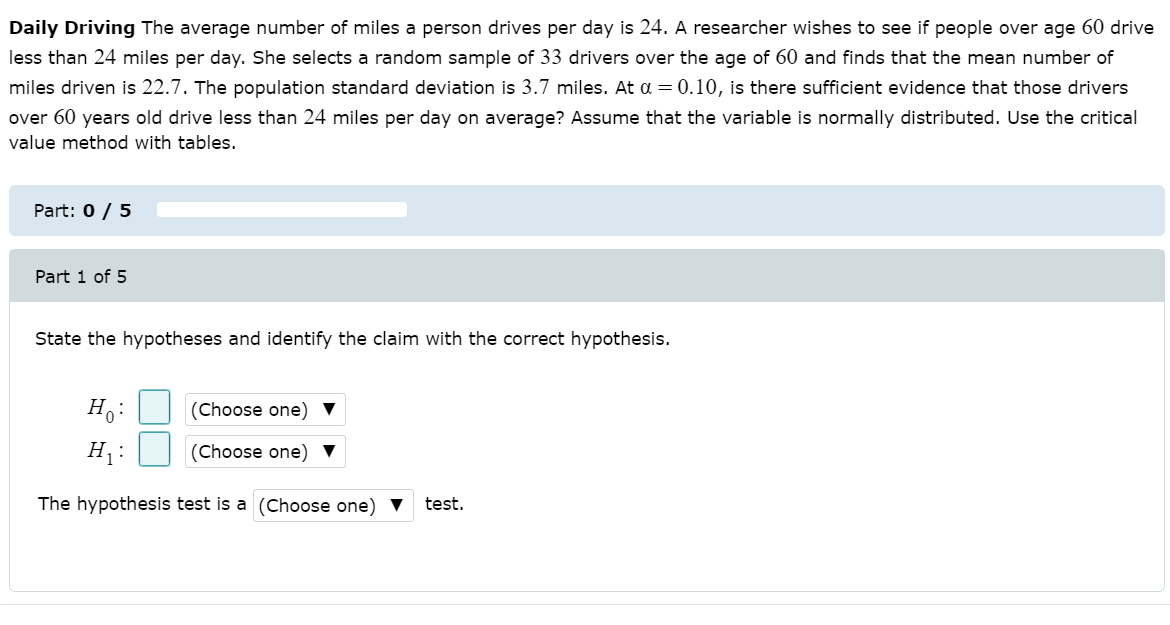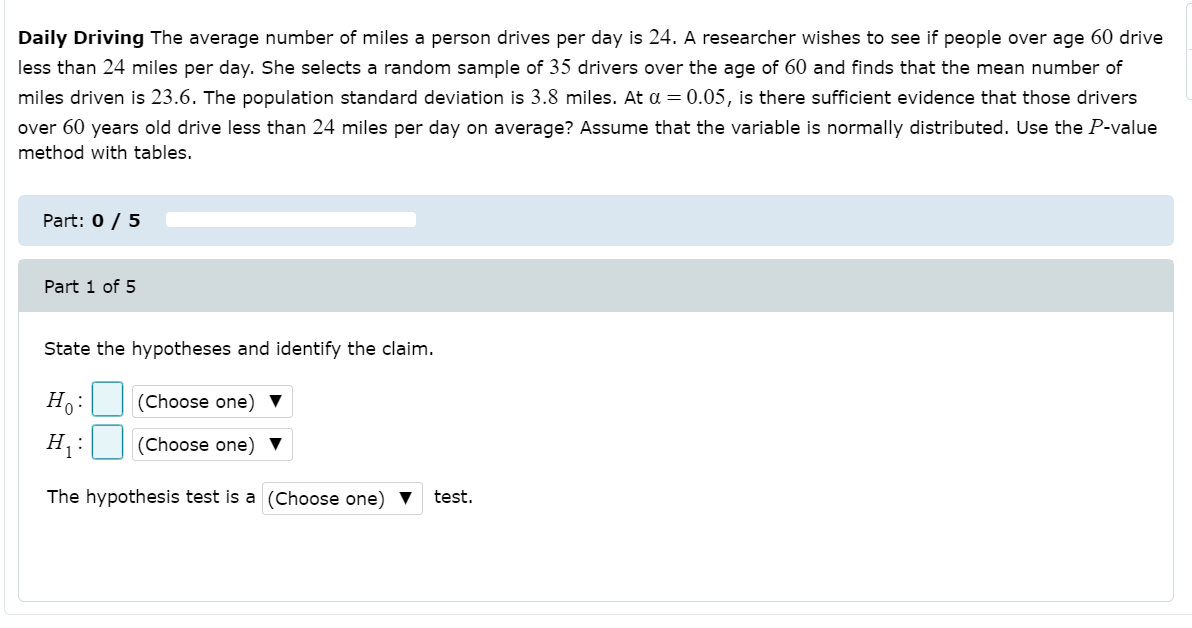Daily Driving The average number of miles a person drives per day is 24. A researcher wishes to see if people over age 60 drive less than 24 miles per day. She selects a random sample of 33 drivers over the age of 60 and finds that the mean number of miles driven is 22.7. The population standard deviation is 3.7 miles. At a = 0.10, is there sufficient evidence that those drivers over 60 years old drive less than 24 miles per day on average? Assume that the variable is normally distributed. Use the critical value method with tables. Part: 0 / 5 Part 1 of 5 State the hypotheses and identify the claim with the correct hypothesis. H: (Choose one) ▼ H : (Choose one) ▼ The hypothesis test is a (Choose one) ▼ test.
Daily Driving The average number of miles a person drives per day is 24. A researcher wishes to see if people over age 60 drive less than 24 miles per day. She selects a random sample of 33 drivers over the age of 60 and finds that the mean number of miles driven is 22.7. The population standard deviation is 3.7 miles. At a = 0.10, is there sufficient evidence that those drivers over 60 years old drive less than 24 miles per day on average? Assume that the variable is normally distributed. Use the critical value method with tables. Part: 0 / 5 Part 1 of 5 State the hypotheses and identify the claim with the correct hypothesis. H: (Choose one) ▼ H : (Choose one) ▼ The hypothesis test is a (Choose one) ▼ test.
A First Course in Probability (10th Edition)
10th Edition
ISBN:9780134753119
Author:Sheldon Ross
Publisher:Sheldon Ross
Chapter1: Combinatorial Analysis
Section: Chapter Questions
Problem 1.1P: a. How many different 7-place license plates are possible if the first 2 places are for letters and...
Related questions
Topic Video
Question
need help on these, everything you need is in the screenshot

Transcribed Image Text:Daily Driving The average number of miles a person drives per day is 24. A researcher wishes to see if people over age 60 drive
less than 24 miles per day. She selects a random sample of 33 drivers over the age of 60 and finds that the mean number of
miles driven is 22.7. The population standard deviation is 3.7 miles. At a = 0.10, is there sufficient evidence that those drivers
over 60 years old drive less than 24 miles per day on average? Assume that the variable is normally distributed. Use the critical
value method with tables.
Part: 0 / 5
Part 1 of 5
State the hypotheses and identify the claim with the correct hypothesis.
H:
(Choose one)
H:
(Choose one)
The hypothesis test is a (Choose one) ▼
test.

Transcribed Image Text:Daily Driving The average number of miles a person drives per day is 24. A researcher wishes to see if people over age 60 drive
less than 24 miles per day. She selects a random sample of 35 drivers over the age of 60 and finds that the mean number of
miles driven is 23.6. The population standard deviation is 3.8 miles. At a = 0.05, is there sufficient evidence that those drivers
over 60 years old drive less than 24 miles per day on average? Assume that the variable is normally distributed. Use the P-value
method with tables.
Part: 0 / 5
Part 1 of 5
State the hypotheses and identify the claim.
H:
(Choose one) ▼
H :
(Choose one) ▼
The hypothesis test is a (Choose one) ▼
test.
Expert Solution
This question has been solved!
Explore an expertly crafted, step-by-step solution for a thorough understanding of key concepts.
This is a popular solution!
Trending now
This is a popular solution!
Step by step
Solved in 3 steps

Knowledge Booster
Learn more about
Need a deep-dive on the concept behind this application? Look no further. Learn more about this topic, probability and related others by exploring similar questions and additional content below.Recommended textbooks for you

A First Course in Probability (10th Edition)
Probability
ISBN:
9780134753119
Author:
Sheldon Ross
Publisher:
PEARSON


A First Course in Probability (10th Edition)
Probability
ISBN:
9780134753119
Author:
Sheldon Ross
Publisher:
PEARSON
